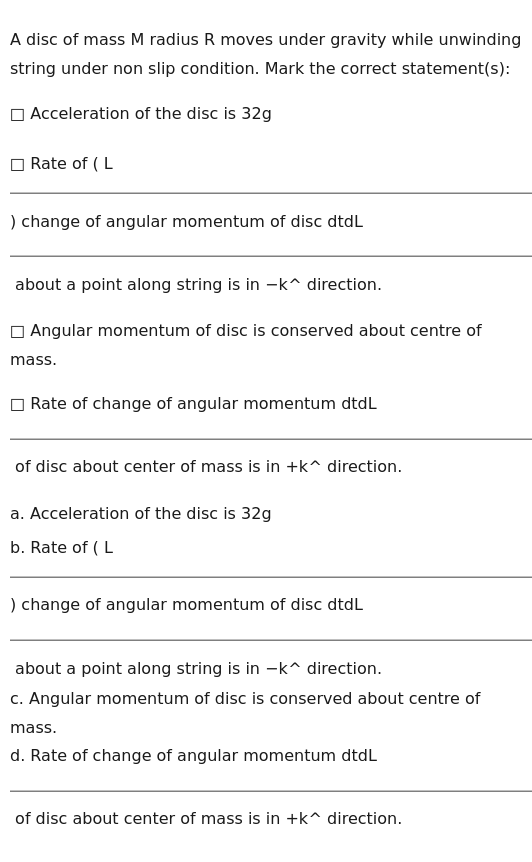Question
Question: A disc of mass M radius R moves under gravity while unwinding string under non slip condition. Mark ...
A disc of mass M radius R moves under gravity while unwinding string under non slip condition. Mark the correct statement(s):
□ Acceleration of the disc is 32g
□ Rate of (L) change of angular momentum of disc dtdL about a point along string is in −k^ direction.
□ Angular momentum of disc is conserved about centre of mass.
□ Rate of change of angular momentum dtdL of disc about center of mass is in +k^ direction.

Acceleration of the disc is 32g
Rate of (L) change of angular momentum of disc dtdL about a point along string is in −k^ direction.
Angular momentum of disc is conserved about centre of mass.
Rate of change of angular momentum dtdL of disc about center of mass is in +k^ direction.
Only Statement 1 is correct.
Solution
Solution:
-
Translation and Rotation:
• Let the disc’s centre have downward acceleration a and angular acceleration α.
• The no–slip (or “no–relative motion”) condition gives a = αR.
• Taking torques about the centre (with the string unwinding tangentially) the lever‐arm is R. Since the string is vertical and the radius to the point of application is horizontal, the torque due to the tension T is
τ = r × T = R T (directed into the page, i.e. –k).
• Thus the rotational equation (about centre) is:
T·R = I_cm·α with I_cm = (1/2) M R²,
⇒ T·R = (1/2) M R² · (a/R) ⇒ T = (1/2) M a. -
Newton’s Second Law (translation):
• mg – T = M a ⇒ mg – (1/2)Ma = M a ⇒ mg = (3/2)M a
• Thus, the acceleration is: a = (2g)/3.
This shows that Statement 1 (“Acceleration of the disc is (2g)/3”) is correct.
- Angular momentum considerations:
• About the centre of mass the net torque is nonzero (τ_cm = –T R, i.e. in –k direction) so the angular momentum about the centre is not conserved. Hence Statement 3 is false.
• Accordingly, Statement 4, which claims that dL/dt about the centre is in the +k direction, is also false.
• In addition, when one takes any point along the string (e.g. the suspension or a point on the string) the net rate of change of angular momentum does not consistently come out along –k; in one useful choice (for instance the point of contact where the string meets the disc) one obtains a contribution from both the (–T R) torque (about the centre) and a term from the centre’s linear motion. A careful calculation shows that the vector sum does not yield –k in general. Thus, Statement 2 is not generally correct.
Answer:
Only Statement 1 is correct.
